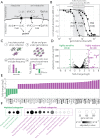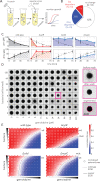Evolved bacterial resistance to the chemotherapy gemcitabine modulates its efficacy in co-cultured cancer cells
- PMID: 36734518
- PMCID: PMC9931390
- DOI: 10.7554/eLife.83140
Evolved bacterial resistance to the chemotherapy gemcitabine modulates its efficacy in co-cultured cancer cells
Abstract
Drug metabolism by the microbiome can influence anticancer treatment success. We previously suggested that chemotherapies with antimicrobial activity can select for adaptations in bacterial drug metabolism that can inadvertently influence the host's chemoresistance. We demonstrated that evolved resistance against fluoropyrimidine chemotherapy lowered its efficacy in worms feeding on drug-evolved bacteria (Rosener et al., 2020). Here, we examine a model system that captures local interactions that can occur in the tumor microenvironment. Gammaproteobacteria-colonizing pancreatic tumors can degrade the nucleoside-analog chemotherapy gemcitabine and, in doing so, can increase the tumor's chemoresistance. Using a genetic screen in Escherichia coli, we mapped all loss-of-function mutations conferring gemcitabine resistance. Surprisingly, we infer that one third of top resistance mutations increase or decrease bacterial drug breakdown and therefore can either lower or raise the gemcitabine load in the local environment. Experiments in three E. coli strains revealed that evolved adaptation converged to inactivation of the nucleoside permease NupC, an adaptation that increased the drug burden on co-cultured cancer cells. The two studies provide complementary insights on the potential impact of microbiome adaptation to chemotherapy by showing that bacteria-drug interactions can have local and systemic influence on drug activity.
Keywords: E. coli; cancer; chemoresistance; computational biology; drug adaptation; evolutionary biology; gemcitabine; microbiome; resistome; systems biology.
© 2023, Sayin et al.
Conflict of interest statement
SS, BR, CL, BH, OP, DW, AW, AM No competing interests declared
Figures











Similar articles
-
Elucidation of the Gemcitabine Transporters of Escherichia coli K-12 and Gamma-Proteobacteria Linked to Gemcitabine-Related Chemoresistance.Int J Mol Sci. 2024 Jun 27;25(13):7012. doi: 10.3390/ijms25137012. Int J Mol Sci. 2024. PMID: 39000123 Free PMC article.
-
Periostin promotes the chemotherapy resistance to gemcitabine in pancreatic cancer.Tumour Biol. 2016 Nov;37(11):15283-15291. doi: 10.1007/s13277-016-5321-6. Epub 2016 Sep 30. Tumour Biol. 2016. PMID: 27696296
-
The oncogenic receptor ErbB2 modulates gemcitabine and irinotecan/SN-38 chemoresistance of human pancreatic cancer cells via hCNT1 transporter and multidrug-resistance associated protein MRP-2.Oncotarget. 2015 May 10;6(13):10853-67. doi: 10.18632/oncotarget.3414. Oncotarget. 2015. PMID: 25890497 Free PMC article.
-
Gemcitabine: metabolism and molecular mechanisms of action, sensitivity and chemoresistance in pancreatic cancer.Eur J Pharmacol. 2014 Oct 15;741:8-16. doi: 10.1016/j.ejphar.2014.07.041. Epub 2014 Jul 30. Eur J Pharmacol. 2014. PMID: 25084222 Review.
-
Gemcitabine chemoresistance in pancreatic cancer: molecular mechanisms and potential solutions.Scand J Gastroenterol. 2009;44(7):782-6. doi: 10.1080/00365520902745039. Scand J Gastroenterol. 2009. PMID: 19214867 Review.
Cited by
-
Pharma[e]cology: How the Gut Microbiome Contributes to Variations in Drug Response.Annu Rev Pharmacol Toxicol. 2025 Jan;65(1):355-373. doi: 10.1146/annurev-pharmtox-022724-100847. Epub 2024 Dec 17. Annu Rev Pharmacol Toxicol. 2025. PMID: 39107044 Review.
-
Antibacterial activity of nonantibiotics is orthogonal to standard antibiotics.Science. 2024 Apr 5;384(6691):93-100. doi: 10.1126/science.adk7368. Epub 2024 Mar 14. Science. 2024. PMID: 38484036 Free PMC article.
-
A thiouracil desulfurase protects Clostridioides difficile RNA from 4-thiouracil incorporation, providing a competitive advantage in the gut.Cell Host Microbe. 2025 Apr 9;33(4):573-588.e7. doi: 10.1016/j.chom.2025.03.001. Epub 2025 Mar 25. Cell Host Microbe. 2025. PMID: 40139192
-
Advances in bio-polymer coatings for probiotic microencapsulation: chitosan and beyond for enhanced stability and controlled release.Des Monomers Polym. 2024 Dec 31;28(1):1-34. doi: 10.1080/15685551.2024.2448122. eCollection 2025. Des Monomers Polym. 2024. PMID: 39777298 Free PMC article. Review.
-
Functional Assay for Measuring Bacterial Degradation of Gemcitabine Chemotherapy.Bio Protoc. 2023 Sep 5;13(17):e4797. doi: 10.21769/BioProtoc.4797. eCollection 2023 Sep 5. Bio Protoc. 2023. PMID: 37719072 Free PMC article.
References
-
- Ashburner M, Ball CA, Blake JA, Botstein D, Butler H, Cherry JM, Davis AP, Dolinski K, Dwight SS, Eppig JT, Harris MA, Hill DP, Issel-Tarver L, Kasarskis A, Lewis S, Matese JC, Richardson JE, Ringwald M, Rubin GM, Sherlock G. Gene ontology: tool for the unification of biology. Nature Genetics. 2000;25:25–29. doi: 10.1038/75556. - DOI - PMC - PubMed
Publication types
MeSH terms
Substances
Grants and funding
LinkOut - more resources
Full Text Sources
Other Literature Sources
Medical

